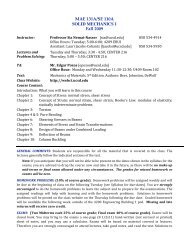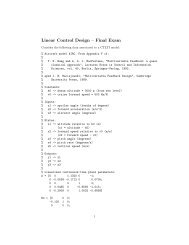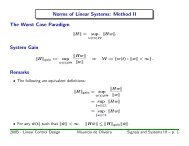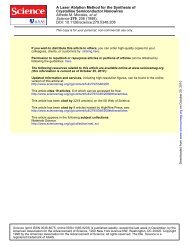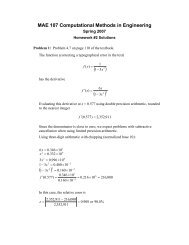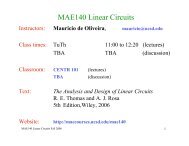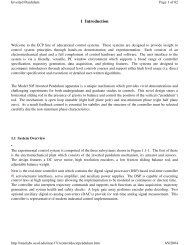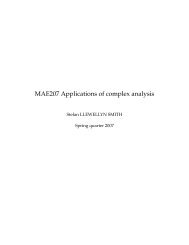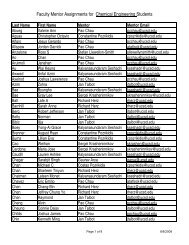Solutions I
Solutions I
Solutions I
Create successful ePaper yourself
Turn your PDF publications into a flip-book with our unique Google optimized e-Paper software.
MAE294B/SIO203B: Methods in Applied Mechanics Winter Quarter 2011<br />
http://maecourses.ucsd.edu/mae294b<br />
<strong>Solutions</strong> I<br />
1 The fixed points are solutions of 2/(x 2 + 1) − x 2 = 0, which gives the biquadratic x 4 + x 2 − 2 =<br />
(x 2 + 2)(x 2 − 1) = 0. The imaginary roots are not relevant so the fixed points are at −1 and 1.<br />
Calculate f ′ (x) = −4x(x 2 + 1) −1 − 2x, so that f ′ (−1) = −3 and f ′ (1) = 3. Hence −1 is unstable<br />
and 1 is stable. The exact solution can be found by separating variables:<br />
x2 + 1<br />
(x2 + 1)(x2 dx = dt.<br />
− 1)<br />
This integrates to<br />
t = 1<br />
3 √ <br />
tan<br />
2<br />
−1 (x0/ √ 2) − tan −1 (x/ √ <br />
2) + 1<br />
3 log (x + 1)(x0 − 1)<br />
(x − 1)(x0 + 1) ,<br />
where x(0) = x0. It is clear that t → ∞ corresponds to x → 1 while t → −∞ corresponds to x → −1.<br />
2 Transforming to polar coordinates gives<br />
Hence we need to solve the system<br />
r˙r = x ˙x + y ˙y = r 2 − r 4 , r 2 ˙θ = x ˙y − y ˙x = r 2 .<br />
˙r = r(1 − r 2 ),<br />
˙θ = 1.<br />
The equations decouple. The angle θ increases linearly with time: θ = θ0 + t. The modulus r<br />
satisfies a nonlinear equation. A phase line analysis shows that 0 is unstable and 1 is stable. Hence<br />
(0,0) is a fixed point, which must be an unstable anticlockwise focus from the form of the r- and<br />
θ-equations, and any other initial condition tends to a periodic orbit with r = 1. The solution to the<br />
r-equation has the solution r = [1 + (r −2<br />
0 − 1)e−t/2 )] −1/2 .<br />
3 (a) The fixed points are at (0,0), (1,0), (0,2) and ( 1 2 , 1 2 ). The matrix of derivatives is<br />
<br />
1 − 2y1 − y2 −y1<br />
D =<br />
− 3 4y2 1<br />
2 − 1 2y2 − 3 4y1 <br />
.<br />
For the fixed point at (0,0),<br />
<br />
1 0<br />
D =<br />
0 1 2<br />
This is an unstable node. For the fixed point at (1,0),<br />
<br />
−1 −1<br />
D =<br />
0 − 1 <br />
4<br />
with eigenvalues/vectors 1, 1 2 and (1,0)T ,(0,1) T .<br />
with eigenvalues/vectors −1,− 1 4 and (1,0)T ,(4,−3) T .<br />
1
This is a stable node. For the fixed point at (0,2),<br />
<br />
−1<br />
D =<br />
−<br />
0<br />
3 2 − 1 2<br />
<br />
This is a stable node. For the fixed point at ( 1 2 , 1 2 ),<br />
<br />
1 −<br />
D = 2 − 1 2<br />
− 3 8 − 1 <br />
8<br />
with eigenvalues/vectors −1,− 1 2 and (1,3)T ,(0,1) T .<br />
with eigenvalues − 5<br />
16 ±<br />
√<br />
57<br />
16 .<br />
This is a saddle.<br />
(b) The fixed point is at (0,0). The matrix of derivatives is<br />
<br />
0 1<br />
D =<br />
∓2a2y1y2 − 1 ±a2 (1 − y2 1 )<br />
<br />
=<br />
0 1<br />
−1 ±a 2<br />
For |a| < √ 2, the fixed point is a clockwise focus, unstable for + and stable for −. For |a| > √ 2,<br />
the fixed point is an unstable node for + and stable for −.<br />
(c) There are fixed points at (0,0) and at (−1.19,−1.48). The second corresponds to y∗ 2 = − 1 6 (270+<br />
6 √ 2019) 1/3 − (270 + 6 √ 2019) −1/3 and y∗ 1 = 2y∗2 /(1 − y∗2 ). The matrix of derivatives is<br />
For the fixed point at (0,0),<br />
<br />
2 1<br />
D =<br />
1 −2<br />
D =<br />
This is a saddle. For the other fixed point,<br />
<br />
−1.24 −6.84<br />
D =<br />
2.48 −0.81<br />
2 + y 3 2 1 + 3y1y 2 2<br />
1 − y2 −2 − y1<br />
<br />
.<br />
<br />
.<br />
with √ 5,− √ 5 and (1, √ 5 − 2) T ,(2 − √ 5,1) T .<br />
with eigenvalues −1.02 ± 4.11i.<br />
This is an anticlockwise stable focus.<br />
(d) The question in the book has changed from edition to edition. In the old one, the set of equations<br />
is<br />
˙y1 = y2, ˙y2 = siny2 − y1.<br />
The fixed point is (0,0). The matrix of derivatives is<br />
<br />
0<br />
D =<br />
−1<br />
1<br />
cosy2<br />
<br />
=<br />
This is a clockwise unstable focus.<br />
In the new one, the set of equations is<br />
0 1<br />
−1 1<br />
˙y1 = y2, ˙y2 = siny1 − y2.<br />
2<br />
<br />
.
The fixed points are at (nπ,0). The matrix of derivatives is<br />
<br />
0 1<br />
D =<br />
cosy1 −1<br />
For even n, these are saddles with λ = − 1 2 ±<br />
√ 3<br />
2 .<br />
λ = − 1 2 ± i<br />
(e) The fixed point is (0,0). The matrix of derivatives is<br />
<br />
2 − 6y2 D =<br />
1 − 2y2 2 1 − 4y1y2<br />
−1 0<br />
√ 5<br />
2 . For odd n, these are anticlockwise stable foci with<br />
<br />
=<br />
2 1<br />
−1 0<br />
This is a degenerate unstable node with eigenvalue/eigenvector 1 and (1,−1) T .<br />
2.5<br />
2<br />
1.5<br />
1<br />
0.5<br />
0<br />
−0.5<br />
3<br />
2<br />
1<br />
0<br />
−1<br />
−2<br />
−3<br />
3<br />
2<br />
1<br />
0<br />
−1<br />
−2<br />
−3<br />
3<br />
2<br />
1<br />
0<br />
−1<br />
−2<br />
−3<br />
(a)<br />
0 1 2<br />
(b) −3<br />
−2 0 2<br />
(d) old<br />
−2 0 2<br />
(e)<br />
−2 0 2<br />
3<br />
2<br />
1<br />
0<br />
−1<br />
−2<br />
−3<br />
0.5<br />
0<br />
−0.5<br />
−1<br />
−1.5<br />
−2<br />
−2.5<br />
10<br />
5<br />
0<br />
−5<br />
(b) +1<br />
−2 0 2<br />
(c)<br />
−2 −1 0<br />
(d) new<br />
<br />
.<br />
−10<br />
−10 0 10<br />
0.5<br />
Figure 1: Phase planes for 3.<br />
3<br />
0<br />
(e)<br />
−0.5<br />
−0.5 0 0.5




